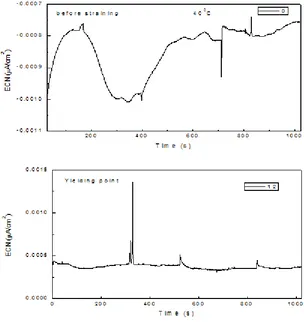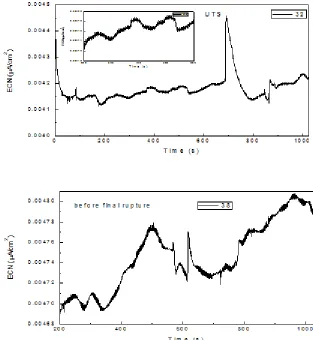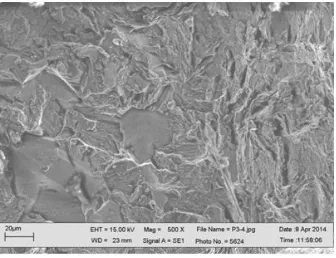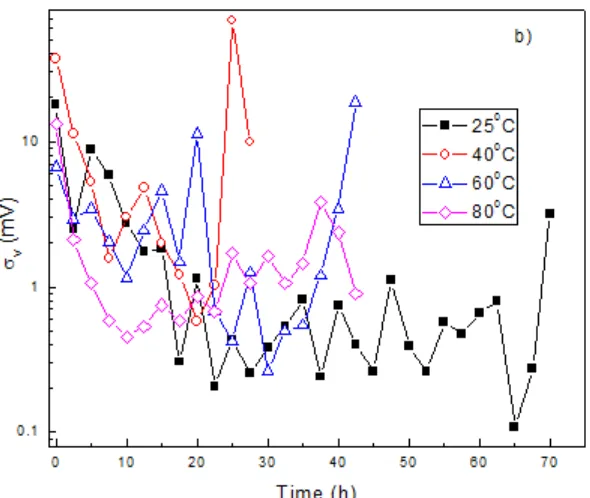Int. J. Electrochem. Sci., 9 (2014) 6717 - 6733
International Journal of
ELECTROCHEMICAL
SCIENCE
www.electrochemsci.orgDetection of Sulfide Stress Cracking in a Supermartensitic
Stainless Steel by Using Electrochemical Noise
C.J. Ortiz Alonso1, M.A. Lucio–Garcia1, I.A. Hermoso-Diaz1, J.G. Chacon-Nava2, A. MArtinez-Villafañe2
, J.G. Gonzalez-Rodriguez1* 1
Universidad Autonoma del Estado de Morelos-CIICAP, Av. Universidad 1001, Col. Chamilpa, 62209-Cuernavaca, Mor., México
2
Centro de Inv. En Materiales Avanzados, Miguel de Cervantes 108, Chihuahua, Chih., Mexico *
E-mail: ggonzalez@uaem.mx
Received: 5 August 2014 / Accepted: 11 September 2014 / Published: 29 September 2014
An effort has been done to use electrochemical noise measurements in order to detect the nucleation and growth of cracks in a 13.5 Cr-4.7 Ni supermartensitic stainless steel in a H2S-containing 3.5% NaCl solution. When the steel was immune to sulfide stress cracking (SSC), time series consisted of low intensity transients (lower than 60 nA/cm2), without a regular frequency, due to strain-assisted metastable pit formation. However, when the steel was susceptible to SSC, time series consisted of periodic, high intensity transients (higher than 60 nA/cm2) with a sudden increase and a slow recovery. Localization index increased during the straining, indicating the presence of localized events such as pits or cracks, regardless of the susceptibility of the steel to SSC. However, this index, by itself, could not distinguish between a pit or a crack. Noise resistance, on the other hand, decreased during the straining, due to the fact that more localized events such as pits or cracks occurred, with a slight increase towards the final rupture due to the re-passivation of the steel.
Keywords: sulfide stress cracking, stainless steel, electrochemical noise.
1. INTRODUCTION
supermartensitic stainless steels [8]. Martensitic stainless steels have been increasingly applied in oil and gas application due to their good corrosion resistance and mechanical properties [9, 10]. Generally they are used in several corrosion conditions and when economical aspects are a critical issue, since they offer better mechanical and corrosion properties than carbon steels [11-14]. Electrochemical noise (EN), which is a non-destructive technique, consists of potential and current fluctuations spontaneously generated by corrosion reactions. EN technique has been increasingly used in field applications [15-19]. It has been extensively used to detect stress corrosion cracking susceptibility of steels, [20,21,23, 26] stainless steels, [22, 24,25, 30] brass, [18, 30] Al-alloys,[30], and Alloy 600 [28] in 3.5 NaCl [18,30], in Na2SO4+H2SO4 [30], in boiling water reactor environments,[15,20,23], in ammonium nitrate + sodium nitrate environments, typical of nuclear waste environments [22], and in 25% Magnesium chloride boiling solution [17]. For instance, Ritter [15] carried out EN measurements on type 304 austenitic stainless steel during constant extension rate tensile tests in aqueous thiosulphate solution at room temperature to detect SCC. Similarly, Rathod [16] carried out stress corrosion cracking studies of aluminum alloys AA2219, AA8090, and AA5456 in heat-treated and non heat-treated condition using electrochemical noise technique with various applied stresses. Electrochemical noise time series data (corrosion potential vs. time) was obtained for the stressed tensile specimens in 3.5% NaCl aqueous solution at room temperature (27 0C). Similarly, Breimesser applied EN measurements to study the initiation and propagation of intergranular stress corrosion cracking in sensitized stainless steel under constant load. [17]. In all cases, current or potential fluctuations were related with the nucleation and propagation of stress corrosion cracks. Thus, the goal of this paper is to use EN measurements to detect SCC of a supermartensitic stainless steel in an H2 S-containing environment.
2. EXPERIMENTAL PROCEDURE
Table 1. Chemical composition of tested steel. (wt. %).
C Mn Si Cr Ni Mo S P Cu N Fe
0.02 0.75 0.3 13.5 4.7 1.7 0.0003 0.016 0.07 0.07 Bal.
Table 2. Mechanical propertie of tested steel.
YS (Ksi) UTS (ksi) Hardness (HRC) % R.A.
99.2 126.1 26 60
Int. J. Electrochem. Sci., Vol. 9, 2014
6719 masked, with the exception of the gauge length. Specimens were subjected to conventional, monotonic slow strain rate tensile (SSRT) at a strain rate of 1.00 x10-6 s-1 at 25, 40, 60 and 80 0C in the testing solution which consisted of 3% NaCl solution, heated, deaerated with nitrogen gas. H2S was produced by reacting 3.53 mg/l Sodium Sulfide (Na2S) with 1.7 mg/l Acetic acid.. All the tests were done at the open circuit potential. The loss in ductility was assessed in terms of the percentage reduction in area (%R.A) by using:
100 . . % x A A A A R i f i
[1]
where Ai and Af are the initial and final area respectively. A susceptibility index to SCC (ISCC) was calculated as follows:
air NACE air SCC A R A R A R I . . % . . % . . %
[2]
where %R.A.air and %R.A.NACE are the percentage reduction in area values in air and in the H2S-containing NACE solution respectively. The closer this index to 1, the higher the susceptibility to SCC.Tensile-fractured specimens were examined by a JEOL scanning electron microscope (SEM). Potentiodynamic polarization curves were performed at a sweep rate of 1 mV/s using a fully automated AC Gill potentiostat controlled with a desk top computer in the NACE solution and test temperatures. For these tests, a saturated calomel reference electrode (SCE) and a graphite auxiliary electrode were used. Polarization curves were performed once the free corrosion potential value (Ecorr) was stable, i.e. it did not change in a 2 mV/min range. Corrosion current values, Icorr, were calculated by using Tafel extrapolation method.EN measurements in both current and potential were recorded during straining using as working electrode the tensile specimenand a nominally identical electrode as second working electrodes, and a reference SCE electrode. EN measurements were made recording the current fluctuations at a sampling rate of 1 point per second in blocks of 1024 readings. EN readings were taken every hour during the whole straining test. A fully automated zero resistance ammeter (ZRA) from ACM instruments was used in this case. Finally, the noise resistance, Rn, was then calculated as the ratio of the potential noise standard deviation, v, over the current noise standard deviation, i, according to Eq. [3]:
Rn = v/i [3]
Removal of the DC trend from the raw noise data was performed in the noise analysis. To accomplish this, a least square fitting method was used. An index called “Localization index”, LI, was calculated as:
LI = i / Irms [4]
and 0.1, the alloy is highly susceptible to localized corrosion; for LI values between 0.01 and 0.001, the alloy is highly susceptible to uniform corrosion. Finally, for LI values between 0.1 and 0.01 the alloy is susceptible to a mixture of localized and uniform corrosion [31].
3. RESULTS AND DISCUSSION
Figure 1. Effect of the temperature in the polarization curves for S41425 in a H2S-containing 3.5% NaCl solution.
Polarization curves for the supermartensitic stainless steel in the H2S-containing solution at different temperatures are shown in Fig. 1. It can be seen that the steel shows an active–passive behavior, with an Ecorr value shifting towards nobler values whereas the Icorr value increased with an increase in the temperature. The passive behavior has been reported to be due to the formation of iron sulfide films on the metal surface [23, 33] which, under some H2S concentrations are compact, adherent and protective. The passivation potential increases with the temperature, but the pitting potential remains more or less stable, making the passive region wider at 250C and it gets narrower as the temperature increases.
[image:4.596.152.450.191.445.2]Int. J. Electrochem. Sci., Vol. 9, 2014
6721
[image:5.596.134.478.55.728.2]
Electrochemical current noise (ECN) time series for the specimen tested at 25 0C is shown in Fig. 2. This specimen was not susceptible to SCC. Before applying any stress, i.e. before straining, time series consisted of irregular (without a regular frequency), high frequency and low intensity transients, less than 1 nA/cm2 indicating a passive state. Similar results were found Ritter for the sensitized 304 type stainless steel in thiosulfate solutions using the constant extension rate tensile tests when specimens were unloaded just after exceeding the nominal yield strength [15].
Once the straining begun, Fig. 2 b, a few transients with higher intensity than those found before straining were present, indicating, perhaps, the rupture of the passive film due to the straining. Uruchurtu and Dawson attributed these irregular current transients to the occurrence of breakdown and passivation processes occurring on the surface [32]. This could also be due to the strain-assisted dissolution or breakdown of the Cr2O3 layer and subsequent dissolution of the bare metal resulting in the formation of an environmentally compatible passive film. Before reaching the ultimatum tensile strength, UTS, Fig. 2 c, the transients did not change neither in intensity or frequency, but before reaching the final rupture, their intensity decreased considerably, Fig. 2 d, indicating that the pitting nucleation and growth has ended.
[image:6.596.147.451.383.705.2]Int. J. Electrochem. Sci., Vol. 9, 2014
6723
Figure 3. Noise in current for S41425 steel strained in the H2S-containing 3.5% NaCl solution at 40 0C a) before straining, b) at the yielding pint, c) near the UTS and d) before final fracture.
[image:7.596.138.451.79.419.2]
Table 3. Dependence of the ISCC parameter as a function of the temperature
T (0C) 25 40 60 80
ISCC 0.25 0.73 0.86 0.92
Int. J. Electrochem. Sci., Vol. 9, 2014
6725
Figure 4. Noise in current for S41425 steel in strained in the H2S-containing 3.5% NaCl solution at 60 0
C a)before straining, b) at the yielding pint, c) near the UTS and d) before final fracture.
[image:9.596.128.475.77.416.2]
Figure 5. SEM micrograph of S41425 steel fractured in the H2S-containing 3.5% NaCl solution at 60 0
[image:10.596.133.469.74.332.2]Int. J. Electrochem. Sci., Vol. 9, 2014
6727
Figure 6. Noise in current for S41425 steel strained in the H2S-containing 3.5% NaCl solution at 80 0C a) before straining, b) at the yielding pint, c) near the UTS and d) before final fracture.
Figure 7. SEM micrograph of S41425 steel fractured in the H2S-containing 3.5% NaCl solution at 80 0
[image:11.596.142.451.77.418.2] [image:11.596.160.438.483.709.2]
A similar behavior to the specimen strained at 600C was found for the test performed at 800C, Fig. 6. Before straining the steel or before reaching the yielding point, Figs. 6 a and b, only a few anodic-going transients were observed. However, once the UTS point was reached, Fig. 6 c, some periodic anodic-ongoing transients with intensity around 60 nA/cm2 were observed. These transients showed a sudden increase in their intensity and a slow recovery, with a small step towards the final phase of the transient, due to the rupture of the protective passive film during straining, similar to those observed at the UTS point for the specimen strained at 600C. These types of transients were associated to the advance of short cracks by Stewart. [18] A micrograph of the fracture surface of this steel, Fig. 7, shows intergranular type of cracks with some evidence of anodic metal dissolution. Allam [35] investigating the SCC behavior of 72Cu–28Zn α-brass alloy in Na2MoO4-, explained the found
intergranular cracks for this alloy suggesting that preferential dissolution and mainly dezincification may take place at the pits and through the pores in air-formed film which enlarges with time and may lead an embrittled zone to crack fairly readily under a tensile load. Since grain boundaries are more active and dissolves at a much faster rate than the grain interior [36], i.e., the anodic sites are the grain boundaries while the grain interiors act as cathodic sites. These signal shapes can be explained by a series of overlapping events of film rupture, anodic dissolution and repassivation, according to the slip dissolution model for crack growth [37, 38].
Towards the end of the final fracture with a continuous straining, the anodic-ongoing transients disappeared and some cathodic–ongoing transients but with an intensity lower than 10 nA/cm2 were observed. The burst type current signals disappeared or were of very low amplitude, thus indicating end of nucleation of stress corrosion cracks.
Breimesser [17], by applying electrochemical noise to monitor stress corrosion cracking of stainless steel in tetrathionate solution under constant load, concluded that large transients preceded by much smaller peaks and rising baseline currents, could be attributed to metastable pit formation and micro crack growth events of film rupture, anodic dissolution and repassivation. Therefore, in that
2
and exhibiting high crack growth rates indicate the coalescence of micro cracks. Further growth and coalescence of the resulting cracks could then cause large fracture events [17]. Pits formed on stainless steel surfaces could either get repassivated before achieving stability or grow to become stable pits [37–38]. The phenomenon of metastable pitting is defined as the initiation of a single pit that gets repassivated immediately without growing further. Very similar results found Ritter for the same steel but in thiosulfate solutions using the constant extension rate tensile tests [15]. Thus, in our case, it seems that transients much smaller than 60 nA/cm2 could be associated to the nucleation of pits, whereas transients with an intensity equal or higher than 60 nA/cm2 are related to the formation of microcracks.
Int. J. Electrochem. Sci., Vol. 9, 2014
[image:13.596.119.502.141.432.2]6729 localized type of corrosion increases. This is because more localized type of corrosion events, such as pitting or cracks, are taking place.
Figure 9. Variation with time of the a) current noise standard deviation, i and b) potential noise standard deviation values, v, for the different SSRT experiments.
At the beginning of the straining, a few localized events such as pitting corrosion due to the passive layer disruption due to straining take place, but as the straining continues, especially once the yielding point has been reached, stress corrosion cracks start to appear and to grow. However, regardless of the testing temperature, the LI values sharply decreases just before the steel reaches the final rupture. This is because, just before reaching the final rupture, the crack grows so fast that the area inside the crack is passivated but,since now there is no straining, this passive film is not broken and protects the steel, so the IL decreases. As mentioned by Dawson [40] anodic transients can also be the results of metal dissolution at the crack wall and therefore, similar to pit initiation. In many cases therefore it is difficult to discriminate between anodic SCC, pitting and crevice corrosion.
[image:14.596.151.446.76.325.2]Int. J. Electrochem. Sci., Vol. 9, 2014
6731 noise resistance value, Rn, as shown in Fig. 10, where it can be seen that its value tends to decrease with time, i.e. an increase in the corrosion rate as time or straining elapses, but towards the end of the test, the Rn value increases.
Figure 10. Variation of the noise resistance value, Rn, with time for the different SSRT experiments.
Additionally, the Rn value decreases as the testing temperature increased similar to the results reported by Girija et al. during the immersion of sensitized AISI type 304 SS in 4 N HNO3 at 298, 323 and 348 K [41], i.e. the corrosion rate increases as the testing temperature increases. The increase in the corrosion rate with the testing temperature was observed in the polarization curves, Fig. 1, thus, there is agreement between the two different techniques. The fact that Rn decreases with time is due to the fact that more localized type of corrosion events, such as pits or cracks are taking place, and maybe close to the rupture of the passive layer inside the crack. If the model of anodic dissolution, as explained above, is the responsible for the crack growth, then the rupture of the passive layer and its repassivation are the responsible for the decrease in the Rn value. However, just before reaching the final rupture, the crack grows so fast that passive layer area inside the crack is not broken by the straining that the steel is protected, binging an increase in the Rn value.
4. CONCLUSIONS
[image:15.596.147.456.157.376.2]
metastable pit formation. However, when the steel was susceptible to SSC, time series consisted of periodic, high intensity transients (higher than 60 nA/cm2) due to the nucleation and growth of intergranular cracks. Localization index increased during the straining, indicating the presence of localized events such as pits or cracks regardless of the susceptibility of the steel to SSC. However, this index could not distinguish between pitting or crack nucleation and growth. On the other hand, the noise resistance value, Rn, decreased during the straining, with a increase towards the final rupture because the steel gets repassivated.
References
1. Trond Rogne, John M. Drugli and Ole Oystein Knudsen: "Corrosion Performance of 13Cr
Stainless Steels", Corrosion 2000. Paper 152, NACE Conf. Div., P.O. Box 218340, Houston, Texas 77218-8340.
2. T. Taira, K. Tsukada, Y. Kobayashi, H. Inagaki, T. Watanabe, Corrosion, 37 (1981) 5. 3. H. Pircher, G. Sussek, Corros. Sci., 27 (1987) 1183.
4. G. Domizzi, G. Anteri, J. Ovejero-Garcĺa, Corros. Sci., 43 (2001) 325.
5. L.W. Tsay, M.Y. Chi, H.R. Chen, C. Chen, Mater. Sci. Eng., 416 A (2006) 155. 6. M.C. Zhao, M. Liu, A. Atrens, Y.Y. Shan,K. Yang, Mater. Sci. Eng., 478A, (2008) 43. 7. S. Ramadan, L. Gaillet, C. Tessier, H. Idrissi, Appl. Surf. Sci., 254 (2008) 2255.
8. The Institute of Materials, Corrosion Resistant Alloys for Oil and Gas Production: Guidance on General Requirements and Test Methods for H2S Service, Maney publishing, 2002, 9.
9. H. Marchebois, J. Leyer, B. Orlans-Joliet, SCC performance of a Super 13 Cr Martensitic Stainless Steel for OCTG: Three-dimensional fitness-for-purpose mapping according to PH2S, pH and chloride content, NACE Corrosion conference (2007), Paper ISBN: 07090 2007 CP, Houston, TX, NACE International.
10. X. Li, T. Bell, Corr. Sci. 48 (2006) 2036.
11. M.D. Pereda, C.A. Gervasi, C.L. Llorente, P.D. Bilmes, Corr. Sci. 53 (2011) 3934. 12. H. Van-der-Winden, P. Toussaint, L. Coudreuse, Past, Present and Future of Weldable
Supermartensitic Alloys, Supermartensitic Stainless Steel, Brussels, Belgium, 2002.
13. T.G. Gooch, P. Woollin, A.G. Haynes, Welding Metallurgy of Low Carbon 13% Chromium Martensitic Steels, Supermartensitic Stainless Steel, Brussels, Belgium, 1999.
14. D. Carrouge, Transformations in supermartensitic stainless steels, Ph.D. thesis, University of Cambridge, Department of Materials Science and Metallurgy, England, 2002.
15. S. Ritter, H. P. Seifert, Materials and Corrosion 64 ( 2013) 683.
16. R.C. Rathod, S.G. Sapate, R. Raman, W.S. Rathod, J. of Materials Engineering and Performance, 22 ( 2013) 3801.
17. Mathias Breimesser, Stefan Ritter, Hans-Peter Seifert, Thomas Suter, Sannakaisa Virtanen, Corr. Sci. 63 (2012) 129.
18. J. Stewart, D.B. Wells, P.M. Scott, Corros. Sci. 33 (1992) 73.
19. M.G. Pujar, N. Parvathavarthini, R.K. Dayal, S. Thirunavukkarasu, Corros. Sci. 51 (2009) 1707. 20. G.L. Edgemon, M.J. Danielson, G.E.C. Bell, J. Nuclear Materials 245 (1997) 201.
21. J. Hickling, D.F. Taylor, P.L. Andresen, Materials and Corrosion 49 (1998) 651. 22. J. Kovac, M. Leban, A. Legat, Electrochim. Acta 52 (2007) 7607.
23. T. Anita, M.G. Pujar, H. Shaikh, R.K. Dayal, H.S. Khatak, Corros. Sci. 48 (2006) 2689. 24. G. Du, J. Li, W.K. Wang, C. Jiang, S.Z. Song, Corros. Sci. 53 (2011) 2918.
25. S.W. Kim, H.P.Kim, Corros. Sci. 51 (2009) 191.
Int. J. Electrochem. Sci., Vol. 9, 2014
6733 28. D. Eden, Corrosion´1998, National Association of Corrosion Engineers, Houston, TX, 1998, paper
No. 386.
29. J. Kovac, C. Alaux, T. James Marrow, E. Govekar, A. Legat, Corros. Sci. 52 (2010) 2015. 30. Z. Shi, G. Song, Ch. Cao, H. Lin, M. Lu, Electrochim. Acta, 52 (2007) 2123.
31. I. A. AL-Zanki, J.S. Gill, J.L. Dawson, Mater Sci Forum 8(1986) 463. 32. J.C. Uruchurtu, J.L. Dawson, Corrosion 43 (1987) 19.
33. H. Ashassi-Sorkhabi, S.A. Nobavi-Amri, Electrochim. Acta 47 (2002) 2239.
34. Nageh K. Allam & Ahmed Abdel Nazeer,Elsayed A. Ashour, J. Solid State Electrochem., 16 (2012) 353.
35. S.C. Sircar, U.K. Chatterjee, M. Zamin, H.G .Vijayendra, Corros Sci 12(1972) 217. 36. R.C. Newman, C. Healey, Corros. Sci. 49 (2007) 4040.
37. P.C. Pistorius, G.T. Burstein, Philosophical Transactions of the Royal Society (London) A 41 (1992) 531.
38. G.S. Frankel, L. Stockert, F. Hunkler, H. Bohni, Corrosion 43 (1987) 429.
39. J.L. Dawson, Electrochemical noise measurement. The definitive in-situ technique for corrosion applications? In: Kearns, J.R., Scully, J.R., Roberge, P.R., Reichert, D.L. Dawson, J.L. (eds.), Electrochemical Noise measurements for Corrosion Applications, STP 1277. ASTM, (1996) 3. 40. S. Girija, U. Kamachi Mudali, H.S. Khatak, Baldev Raj, Corr. Sci. 49 (2007) 4051.









